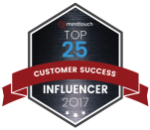This post originally appeared on The Success League blog.
As you’re checking your calendar to start the day, you see there is a two hour block for “QBR Prep” at 10:00 am. The room suddenly feels a lot warmer and beads of sweat appear on your forehead. You think to yourself “did someone mess with the thermostat?” You then remember that this the normal feeling you get when preparing a QBR. It’s such a massive pain to put together. You have to pull data from 10 different places and then put all of the pieces together so it will make sense. You’re also praying that the attendees will actually show up. Beyond your scheduled QBR prep, you have an overflowing inbox of customer emails and a bunch of other flashing messages in Slack. You don’t want to let any of your customers down but you have no idea how you are going to pull this all off.
That feeling of trepidation and despair when tackling a QBR is a common occurrence. While the practice of customer success has evolved, some of the strategies haven’t changed that much for many organizations. QBRs definitely fit into that bucket. I see the purpose of a Quarterly Business Review as a way for CSMs to demonstrate and sell the value of your product to the customer. While many companies present these results on a quarterly cadence, I don’t believe that the timing is relevant. It should be based on the needs of your customers.
Unfortunately, many QBRs are still handled like they were in prehistoric days of customer success. They mimic the 1:1 account management relationship that CSMs had with their customers. Times have changed. I’ll cover two common myths of QBRs and what you can do to modify your QBR strategy. This should not only help you with your QBR prep but it should impact your overall approach to Customer Success.
Myth #1: QBRs need to be meetings
There is a misconception that ties a QBR to an actual customer meeting. That is completely outdated and an unrealistic expectation. Do you think you think your customers really want to meet with you or have the availability? A recent survey sheds some light on this.
According to OKTA’s latest Businesses @ Work survey the average company deployed 131 apps for their users last year. 131 apps! In addition, since 2015, the average number of apps per company has grown by 43%. The more apps that your customers are using, the lower the chance you have to schedule an actual customer QBR meeting. You have to face this reality and prepare for it.
CUSTOMER SUCCESS ≠ ACCOUNT MANAGEMENT
Customer Success needs to break away from the traditional 1:1 high touch, account management mindset. We should be thinking about how we deliver a QBR in the same way that Amazon thinks about how it delivers your packages. The focus is always on the customer and improving the overall experience to meet the demands of the customer and the reality that exists.
The other problem is that CSMs don’t have time for these meetings either. Beyond your most strategic customers, it’s unrealistic to expect a CSM to have a QBR with all of their customers due to the growing CSM per customer ratios. To set these impossible goals can only demoralize CSMs and cause unnecessary burnout. We need to move beyond the traditional account management approach.
ONE SIZE DOESN’T FIT ALL
Meeting with your most strategic customers to review the QBR makes total sense. These customers are the core of your business. What doesn’t make sense is treating all customers in the same way. You should differentiate the customer journey based on your segmentation strategy. For the smaller customers this means going beyond just reducing the cadence of QBR to say every 6 months from the normal quarterly format. You should focus on how you can deliver the right type of information in the right way based on the outcome that you are trying to achieve.
One of the best approaches I’ve seen here is to partner with your Operations/Data teams to automate the creation of your QBRs using a business intelligence platform or an Excel template. You need to take the QBR creation out of the hands of CSMs and simplify the process. CSMs will still need to do some slight customizations of the QBR messaging in some cases but the majority of the work should be automated.
There also needs to be further innovation in the delivery of the QBR. As an example, I’ve seen QBRs delivered via email with the summary points clearly stated in the email and a Calendly link that invites the customer’s stakeholders to setup a meeting with the CSM if they want to further discuss the results. All of the email engagement data is tracked so if there is no email clicks or opens, a task is created for the CSM to follow up directly. CSMs could even personalize a QBR by creating a standard video to go along with the email. This whole area of QBR delivery is ripe for even more innovation.
Myth #2 Substance is more important than style for QBRs
I admit it. I’ve delivered QBRs where I just barfed up a lot of content all over the customer and hoped that something stuck. It sounds disgusting doesn’t it? I gave myself a big pat on the back for just finishing all of those slides.
Years later I realize that my approach was completely unacceptable. I was more concerned with creating the powerpoint then orchestrating the content to actually make sense. The style, design and the layout of the content can be just as important as the content.
SHOWING VALUE ISN’T ENOUGH. YOU HAVE TO SELL IT
Think of your QBR like a window display at your favorite store. It’s not enough to have a QBR that demonstrates the value of your product. You need to sell that value. The actual QBR document should be self-explanatory and you should expect it that it will be passed around within the customer’s organization. For this to occur, the value points in your QBR need to be optimized so that they jump off the page. It should be clear to anyone that picks up the document what progress has been made, what value has been provided, and where the opportunities lay.
As an example, the Updater QBR includes awards for the top properties that our customers manage. To our surprise, one of our customers took a screenshot of our QBR and posted it on LinkedIn along with an endorsement of our product.

This customer was so proud of what they achieved that they wanted to share it with their social network. While we didn’t expect our customer to share this with the public, my team did spend many painstaking hours determining what would resonate most with our customers and they architected a template that would make the content stand out. They kept asking: “What would our customers perceive as value? How do we want our customers to feel after the QBR?” Their efforts paid off. We now can make other subtle design changes such as including a small banner in the QBR that would encourage our customers to share this on their LinkedIn or Instagram feeds.
CUSTOMER SUCCESS OPERATIONS ISN’T EVERYTHING; IT’S THE ONLY THING.
To improve the style of your QBR and to simplify the QBR creation process, you need to invest in customer success operations. As an example, at a former company we had our data team automatically export our QBR data to a professionally designed excel template. The charts were uniformly created with vivid colors and up to date industry benchmark data. The CSMs had to simply review the data, add in some customer specific information and create a PDF of the spreadsheet. While we had formal meetings with our strategic customers, we sent the spreadsheet via email to our smaller customers and measured their engagement. We had essentially created an assembly line for QBRs due to the operational rigor we instituted.
The challenge is that companies aren’t investing enough in CS operations. The recent Coastal Cloud Customer Success Industry Report specifies that only 12% of those they surveyed had a Customer Success Operations role. Customer Success must look for leverage. Tasking your already swamped CSMs to create professionally designed QBRs at scale is nearly an impossible ask once you get to a certain size. CSMs will always be a critical component in QBR prep but there needs to be a strong operational arm that can leverage the technology that exists.
Pulling together a QBR can be overwhelming but you can reduce the anxiety associated with it. By changing the way that you deliver the QBR, leveraging CS operations, and making changes to how it’s created, you can drastically decrease the time needed to prepare for and deliver the QBR. You can now concentrate on the the message you want to deliver and provide the experience that is most appropriate based on the customer lifecycle that you created. You can focus on the outcome of the QBR and not on your powerpoint skills. You can focus on engaging your customers and selling the value of your product and not on your fierce powerpoint and excel abilities.
You have the confidence that your QBR will be so well received that your customer will probably share the document with others in their organization. Maybe they will demand an early renewal? Ok, let’s not get too carried away.
There are so many ways that we can improve the entire QBR process and we’ve barely scratched the surface. What are you going to do to improve your next QBR?




